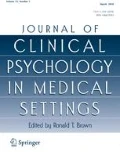Abstract
Patients with insomnia respond best to cognitive-behavioral treatments (CBT) if they find the approach acceptable. One tool, the Insomnia Treatment Acceptability Scale (ITAS), has been used to identify such patients, however, its reliability and validity has not been well established especially in primary care. The purpose of this study was to assess the reliability and validity of the ITAS in a primary care setting. A cross-sectional survey was conducted with 236 primary care patients, aged 18 and above, with clinically significant insomnia (Insomnia Severity Index ≥8). Descriptive and summary statistics, Cronbach’s alpha, Principal Axis Factor analysis with Promax rotation, and comparison of ITAS subscale scores with self-reported treatment preferences (Chi-Square) are included. Factor analysis identified two factor solutions for the ITAS subscales. The ITAS was shown to be a reliable and valid tool that can be used to facilitate psychological practice and research on interdisciplinary behavioral-medical care.
Similar content being viewed by others
References
Bastien, C. H., Vallières, A., & Morin, C. M. (2001). Validation of the Insomnia Severity Index as an outcome measure for insomnia research. Sleep Medicine, 2, 30–297.
Bluestein, D., Rutledge, C. M., & Healey, A. C. (2010). Psychosocial correlates of insomnia severity in primary care. Journal American of Board Family Medicine, 23, 204–211.
Buscemi, N., Vandermeer, B., Friesen, C., Bialy, L., Tubman, M., Ospina, M., et al. (2005). Manifestations and management of chronic insomnia in adults. Evidence Report/Technology Assessment (Summary), 125, 1–10.
Culpepper, L. (2005). Insomnia: A primary care perspective. Journal of Clinical Psychiatry, 66, 14–17.
Epstein, D. (2006). Treatment preference: Applications in insomnia research and behavioral interventions for insomnia participant preferences. Community Nursing Research, 39, 163.
Hofmann, S. G., Barlow, D. H., Papp, L. A., Detweiler, M. F., Ray, S. E., Shear, K., et al. (1998). Pretreatment attrition in a comparative treatment outcome study on panic disorder. American Journal of Psychiatry, 155, 43–47.
Horn, J. L. (1965). A rationale and a test for the number of factors in factor analysis. Psychometrika, 30, 179–185.
Kahn, J. H. (2006). Factor analysis in counseling psychology research, training, and practice: Principles, advances, and applications. Counseling Psychologist, 34, 648–718.
Kathol, R. G., Butler, M., McAlpine, D. D., & Kane, R. L. (2010). Barriers to physical and mental condition integrated service delivery. Psychosomatic Medicine, 72(6), 511–518.
Keenan, R. A., Wild, M. R., McArthur, I., & Colin, A. E. (2007). Children with developmental disabilities and sleep problems: Parental beliefs and treatment acceptability. Journal of Applied Research in Intellectual Disabilities, 20, 455–465.
Mezick, E. J., Matthews, K. A., Hall, M., Strollo, P. J., Jr., Buysse, D. J., Kamarck, T. W., et al. (2008). Influence of race and socioeconomic status on sleep: Pittsburgh Sleep SCORE Project. Psychosomatic Medicine, 70, 410–416.
Morin, C. M. (1993). Insomnia: Psychological assessment and management. New York: Guilford Press.
Morin, C. M. (2006). Combined therapeutics for insomnia: Should our first approach be behavioral or pharmacological? Sleep Medicine, 7, S15–S19.
Morin, C. M., Beaulieu-Bonneau, S., LeBlanc, M., & Savard, J. (2005). Self-help treatment for insomnia: A randomized controlled trial. Sleep, 28, 1319–1327.
Morin, C. M., Bootzin, R. R., Buysse, D. J., Edinger, J. D., Espie, C. A., & Lichstein, K. L. (2006). Psychological and behavioral treatment of insomnia: Update of the recent evidence. Sleep, 29, 1398–1414.
Morin, C. M., Gaulier, B., Barry, T., & Kowatch, R. A. (1992). Patients’ acceptance of psychological and pharmacological therapies for insomnia. Sleep, 15, 302–305.
National Institute of Health: Trans-NIH Sleep Research Coordinating Committee. (2003). National sleep disorders research plan. US Department of Health and Human Services. http://www.nhlbisupport.com/sleep/research/research-a.htm.
National Institute of Health. (2005). State-of-the-Science Conference Statement on manifestations and management of chronic insomnia in adults. NIH Consensus State Science Statements, 22, 1–30.
Robert Graham Center. (2007, November). The patient centered medical home: History, seven core features, evidence and transformational change. http://www.graham-center.org/online/etc./medialib/graham/documents/publications/mongraphs-books/2007/rgcmo-medical-home.Par.0001.File.tmp/rgcmo-medical-home.pdf. Accessed 10 September 2009.
Sateia, M. J., & Nowell, P. D. (2004). Insomnia. Lancet, 364, 1959–1973.
Silber, M. H. (2005). Clinical practice and chronic insomnia. New England Journal Medicine, 353, 803–810.
Vallières, A., Morin, C. M., Guay, B., Bastien, C. H., & LeBlanc, M. (2004). Sequential treatment for chronic insomnia: A pilot study. Behavioral Sleep Medicine, 2, 94–112.
Vincent, N., & Lionberg, C. (2001). Treatment preference and patient satisfaction in chronic insomnia. Sleep, 24, 411–417.
Walker, B. B., & Collins, C. A. (2009). Developing an integrated primary care practice: Strategies, techniques and a case illustration. Journal of Clinical Psychology, 65, 268–280.
Whitworth, J. D., Crownover, B. K., Nichols, W., & Hallgren, J. D. (2007). Clinical inquiries: Which nondrug alternatives can help with insomnia? Journal of Family Practice, 56, 836–840.
Wickwire, E. M., Schumacher, J. A., & Clarke, E. J. (2009). Patient-reported benefits from the pre-sleep routine approach to treating insomnia: Findings from a treatment development trial. Sleep and Biological Rhythms, 7, 71–77.
Zwarenstein, M., Goldman, J., & Reeves, S. (2009). Interprofessional collaboration: Effects of practice-based interventions on professional practice and healthcare outcomes. Cochrane Database System Review, (3), CD000072.
Acknowledgment
This research was funded by the American Academy of Family Physicians Foundation Grant G0605.
Author information
Authors and Affiliations
Corresponding author
Rights and permissions
About this article
Cite this article
Healey, A.C., Rutledge, C.M. & Bluestein, D. Validation of the Insomnia Treatment Acceptability Scale (ITAS) in Primary Care. J Clin Psychol Med Settings 18, 235–242 (2011). https://doi.org/10.1007/s10880-011-9257-0
Published:
Issue Date:
DOI: https://doi.org/10.1007/s10880-011-9257-0




